Road freight transport statistics
Data extracted in July 2024.
Planned article update: July 2025.
Highlights
In 2023, total EU road freight transport amounted to more than 13.2 billion tonnes and 1 857 billion tonne-kilometres.
‘Food products, beverages and tobacco' dominated EU freight transport by road in 2023, accounting for 308 billion tonne-kilometres.
The freight transported by road in a country’s territory in terms of tonnes was the highest in Germany in 2023.
In 2023, Germany was the origin or destination of almost half of the top 20 country-to-country flows in intra-EU road freight transport.
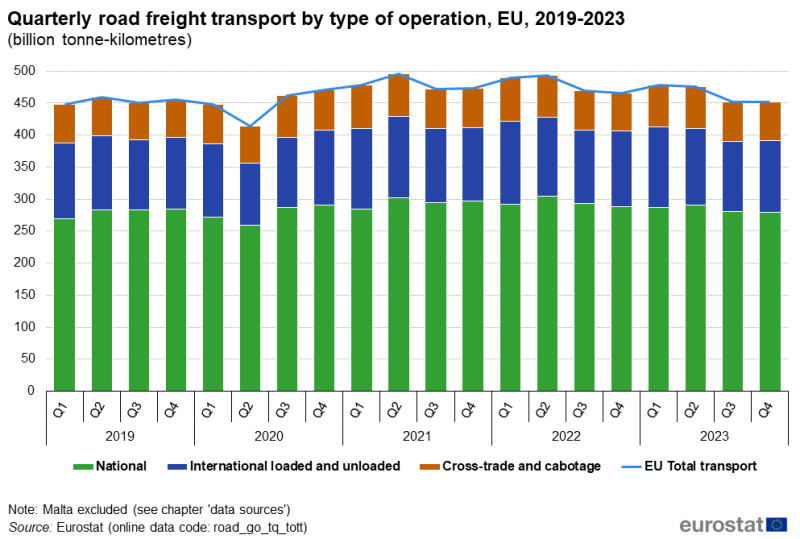
(billion tonne-kilometres)
Source: Eurostat (road_go_tq_tott)
This article presents the main trends in road freight transport in the European Union (EU) up to and including 2023. National, international, cross-trade and cabotage transport are all analysed. Road freight transport by type of goods and distance class are also presented, as are goods moved on the national territory of countries and country-to-country flows.
This article, together with the articles 'Road freight transport by vehicle characteristics', 'Road freight transport by type of goods', 'Road freight transport by journey characteristics' and 'Road freight transport statistics - cabotage' present a complete overview of road freight transport in Europe.
Full article
The total EU road freight transport performance in 2023 decreased compared with 2022
In terms of tonne-kilometres (tkm), European road freight transport decreased by 0.1% from 2021 to 2022 (from 1 921 billion tkm to 1 919 billion tkm). In 2023, total European road freight transport performance continued to decrease, by 3.2% compared with 2022, falling to 1 857 billion tkm (see Table 1 and Figure 1 – all figures presented in tables and graphs can be seen in the ‘Source data’ file).
International transport, representing one quarter (25.1%) of total road freight transport in the EU in 2023, rose by 0.9% from 2021 to 2022, but then decreased by 4.4% in 2023 compared with 2020 2022 (see Table 1). National transport, which represented almost two thirds (61.3%) of the total, decreased by 0.1% in 2022 and by further decreased 3.3% in 2023. Cross-trade and cabotage transport, together representing 13.6% of the EU total in 2023, also decreased by 0.4% and 0.8%, respectively, compared with 2022. In 2022, both have recorded decreases from the previous year, by 0.2% and 9.0%, respectively.
In 2023, Poland (20.3% of EU total tkm) re-confirmed its position as one of the most important countries for road transport in Europe, ahead of Germany (15.4%) and Spain (14.2%). Almost two thirds (64.3%) of the Polish transport performance were either international transport, cross-trade or cabotage, while national transport accounted for just over one third (35.7%).
Compared with 2022, total road freight transport fell in 20 EU countries in 2023, with the most significant decreases recorded in Portugal (-16.4%), Slovakia (-16.2%) and Sweden (-11.5%). The remaining 6 EU countries recorded increases, the highest ones in Lithuania (+17.3%), Denmark (+8.2%) and Cyprus (+7.8%) (see Figure 1). In 2022, total road freight transport had fallen compared with 2021 in 12 EU countries, ranging from -13.3% in Estonia to -0.9% in France. In 12 other EU countries, total road freight transport had increased, ranging from +29.8% in Cyprus to +0.2% in Croatia. In Bulgaria and Portugal total road freight transport had remained stable during these 2 years.
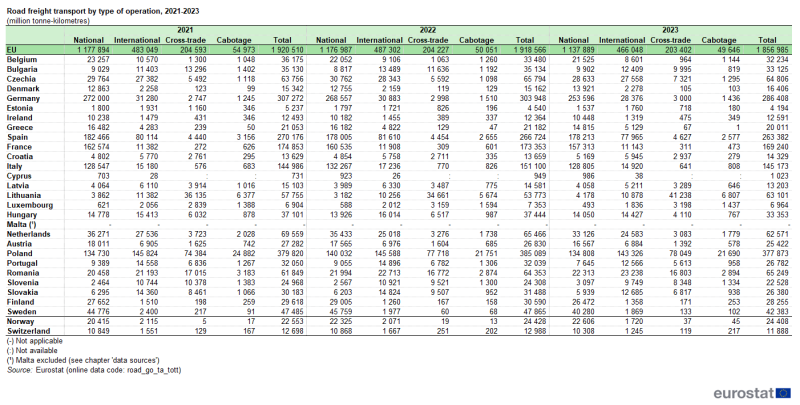
(million tonne-kilometres)
Source: Eurostat (road_go_ta_tott)
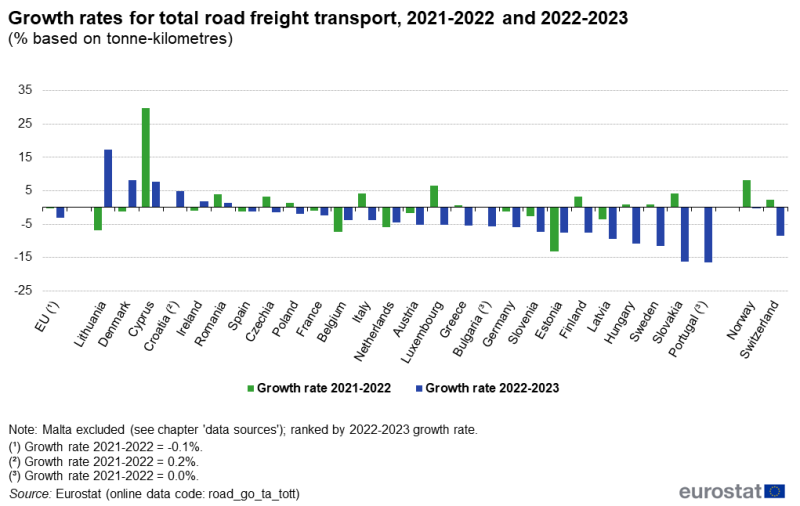
(% based on tonne-kilometres)
Source: Eurostat (road_go_ta_tott)
Road freight transport performance in the EU increased in 2021, following the recovery after the COVID-19 crisis. The second quarter of 2021 represented a peak, at 496.4 billion tkm (see Figure 2). In 2022, total EU road freight transport remained relatively stable, with a higher performance in the first quarter compared with the same quarter of the previous year (+2.5%) and small decreases in the following 3 quarters (-0.7%, -0.6% and -1.6%, respectively), bringing the overall total transport in 2022 close to the same level as in 2021. The road freight transport performance continued to decrease throughout 2023: -2.3% in the first quarter compared with the same quarter of the previous year, -3.6% in the second quarter, -3.8% in the third quarter and -3.1% in the last quarter. In the last 2 quarters of 2023, total EU road freight transport fell to levels not recorded since before the COVID-19 crisis.

(billion tonne-kilometres)
Source: Eurostat (road_go_tq_tott)
The main goods categories transported in 2023 were the same as in 2022, both in terms of tonnes and tonne-kilometres
In terms of tonnage, European road freight transport decreased by 3.4% in 2023, compared with 2022 (from 13 620 million tonnes to 13 153 million tonnes – see Table 2). In 2023, as in previous years, 'metal ores and other mining and quarrying products' was the largest product group transported, accounting for 3 142 million tonnes. Other important product groups were 'other non-metallic mineral products' (1 561 million tonnes), 'food, beverages and tobacco' (1 551 million tonnes) and 'agricultural, forestry and fishery products' (1 267 million tonnes). The most notable increases between 2022 and 2023 were recorded for ‘transport equipment’ (up by 12.4%), ‘furniture’ (9.7%) and ‘coal and lignite’ (7.6%). At the other end of the scale, significant decreases were recorded for the product groups ‘other non metallic mineral products’ (-11.2%), ‘other goods‘ (-6.6%) and ‘metal ores and other mining and quarrying products’ (-6.0%).
In terms of tonne-kilometres, ‘food products, beverages and tobacco' continued to dominate road freight transport in 2023, accounting for 308 billion tkm, followed by 'grouped goods' (230 billion tkm) and 'agricultural products' (198 billion tkm). Notable increases between 2022 and 2023 were recorded for ‘coal and lignite’ (up by 105.5%), ‘transport equipment’ (8.6%) and ‘furniture’ (8.1%), while the highest decreases were recorded for ‘other goods’ (-15.9%), ‘other non metallic mineral products’ (-13.3%) and ‘chemicals, chemical products, and man-made fibres’ (-8.3%).
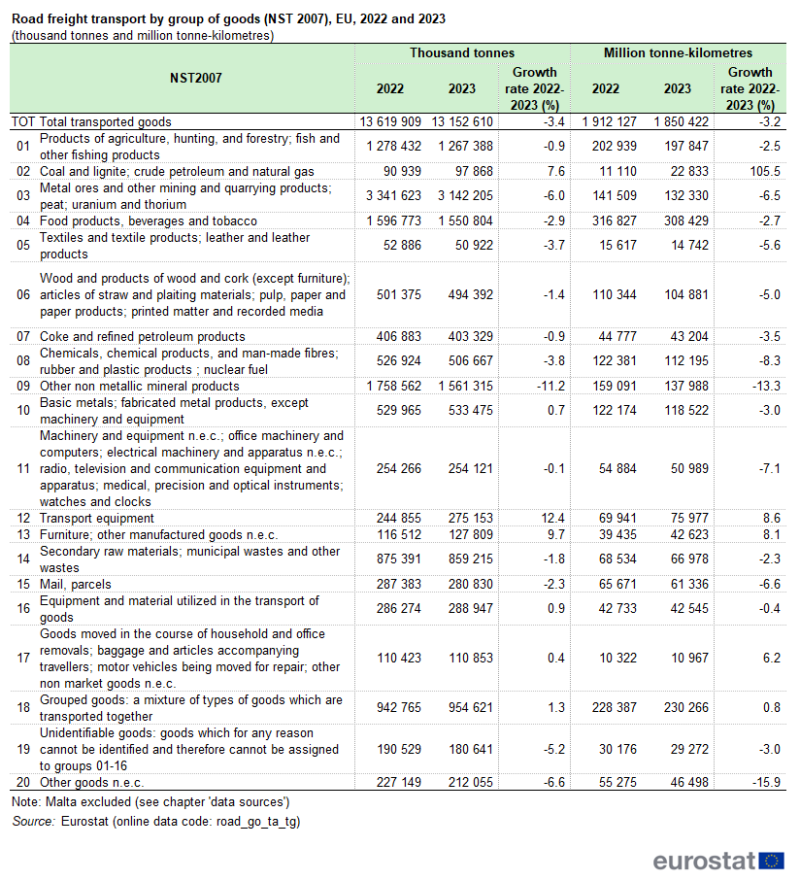
(thousand tonnes and million tonne-kilometres)
Source: Eurostat (road_go_ta_tg)
Transport decreased in all distance classes in 2023
Most of the EU road freight traffic is carried out within 3 distance classes: from 150 to 299 km, from 300 to 499 km and from 500 to 999 km (see Table 3). In 2023, these 3 distance classes together totalled 1 110 billion tkm of the total EU road freight transport, a decrease of 3.2% compared with 2022. The highest road freight transport performance over these 3 distance classes was recorded in Poland (220 billion tkm) and Germany (179 billion tkm), while the lowest were recorded in Estonia (2 billion tkm), Luxembourg and Latvia (5 billion tkm each).
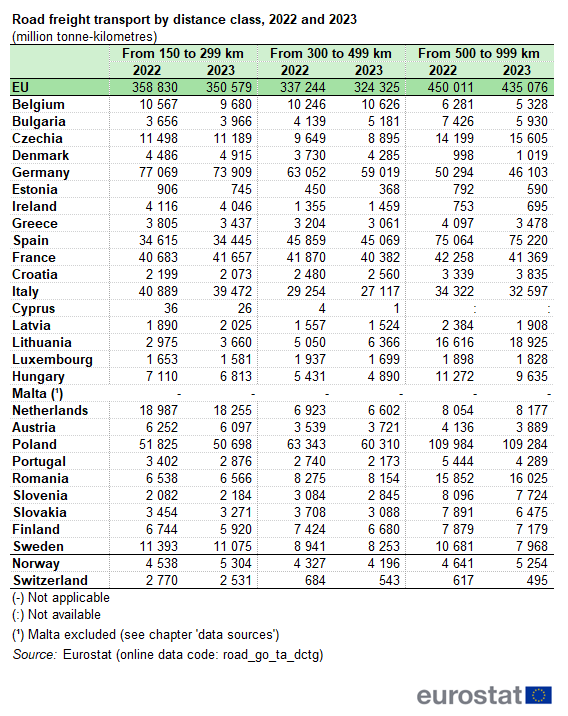
(million tonne-kilometres)
Source: Eurostat (road_go_ta_dctg)
Figure 3 shows trends in road freight transport for different distance classes since 2019. Almost all distance classes recorded decreases in tonne-kilometres performed in 2020 compared with the previous year, ranging between -0.3 percentage points (pp) (for the distance class from 150 to 299 km) and -8.5 pp (for the distance class from 1 000 to 1 999 km). The only distance class which remained relatively unchanged was the one from 300 to 999 km. This development was heavily influenced by the COVID-19 crisis. The next year, following the post-COVID-19 recovery, increases were recorded in all distance classes. The year 2021 was marked by strong increases in all distance classes, ranging from 13.9 pp (for the distance class from 1 000 to 1 999 km) to 5.5 pp (for the distance class of less than 150 km). Compared with 2021, in 2022 EU road freight transport decreased for the distance classes of less than 150 km; from 150 to 299 km; as well as for the class from 1 000 to 1 999 km (-1.1 pp, -1.4 pp and -2.3 pp, respectively). The remaining distance classes (from 300 to 999 km; and over 2 000 km) recorded increases of 0.8 pp each. Road freight transport by distance class continued to fall in 2023, with decreases in all classes: -3.8 pp from 300 to 999 km; -3.7 pp for over 2 000 km; -3.6 pp from 1 000 to 1 999 km; -3.3 pp for less than 150 km; and -2.4 pp from 150 to 299 km.
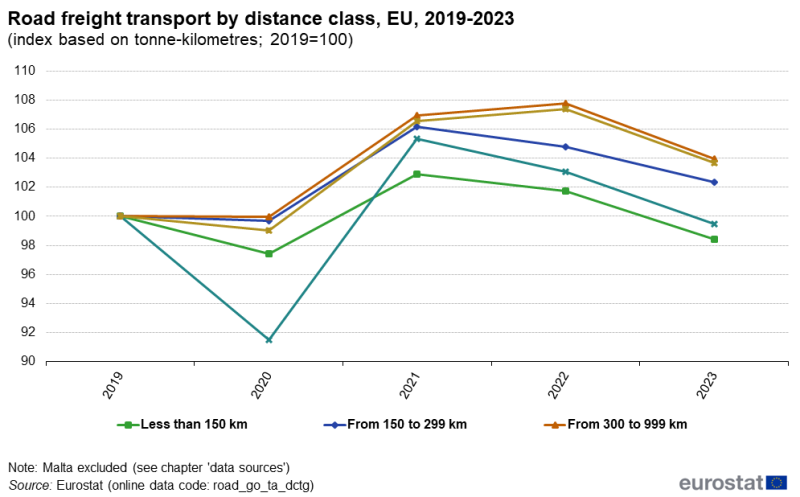
(index based on tonne-kilometres; 2019=100)
Source: Eurostat (road_go_ta_dctg)
Table 4 shows road freight transport by group of goods for 2022 and 2023, measured in tonnes, split between movements of less than 300 km and movements of 300 km or more. For transport of less than 300 km, 'transport equipment' and ‘furniture’ were the product groups that recorded the most significant increases (+13.4% and +10.4%, respectively). The highest decreases were recorded for ‘Other non metallic mineral products’ (-11%), ‘metal ores and other mining and quarrying products’ and ‘unidentifiable goods’ (-6.0% each). Overall, the tonnage transported for less than 300 km decreased by 3.4% from 2022 to 2023.
The tonnage transported for 300 km and more also decreased between 2022 and 2023. The most notable changes were the high increases for ‘coal and lignite’ and ‘transport equipment’ (up by 82.7% and 10.1%, respectively). The highest decreases were recorded for ‘other goods’ and ‘other non metallic mineral products’ (-18.8% and -14.1% respectively).
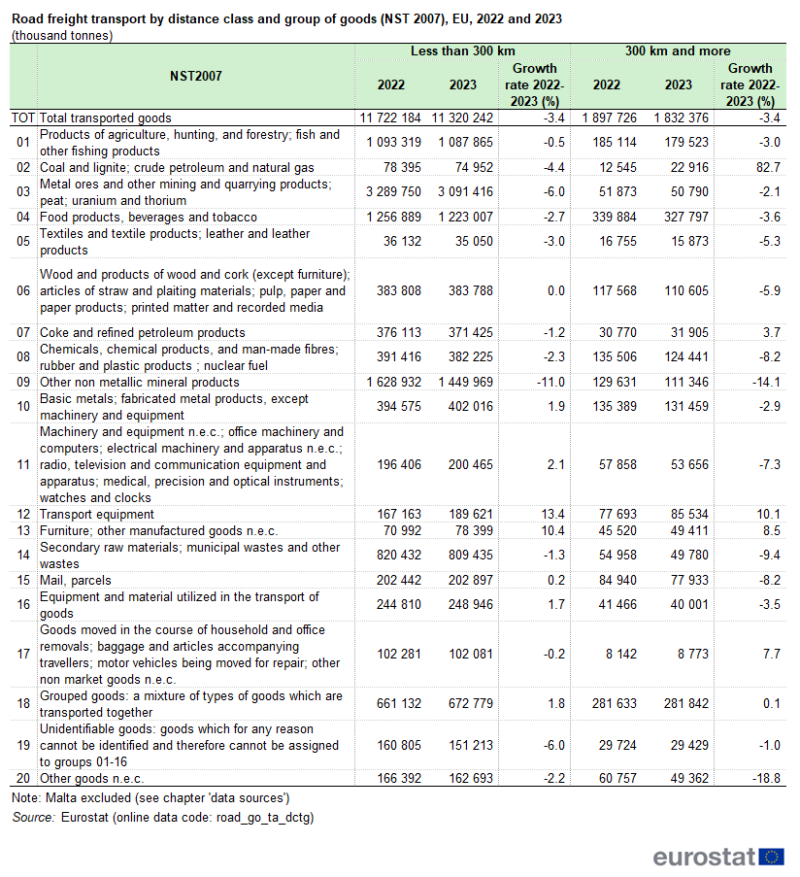
(thousand tonnes)
Source: Eurostat (road_go_ta_dctg)
In 2023, Germany, France, Spain, Poland and Italy together accounted for almost two thirds of the total tonnage transported in the EU
When looking at total transport in 2023, the tonnes of goods transported within Germany (national transport) or loaded/unloaded in Germany (international transport) represented almost one quarter of the total tonnage (22.8%) in the EU, with France and Spain also making up around one quarter together (12.4% and 11.7%, respectively). These countries, along with Poland and Italy accounted for close to two thirds (65.4%) of the total transport of goods by road in the European Union (see Figure 4).
Also, in terms of transport on the national territory, Germany, France, Spain, Poland and Italy recorded the highest tonnages among the EU countries in 2023.
Considering international transport (i.e., goods entering and leaving the country, including cross-trade), the pattern has not changed significantly over the last few years. International transport of goods loaded/unloaded in Germany remained the highest tonnage, ahead of France. The Netherlands and Belgium, with their large North Sea ports, also recorded relatively high tonnages of loaded/unloaded goods for international transport.
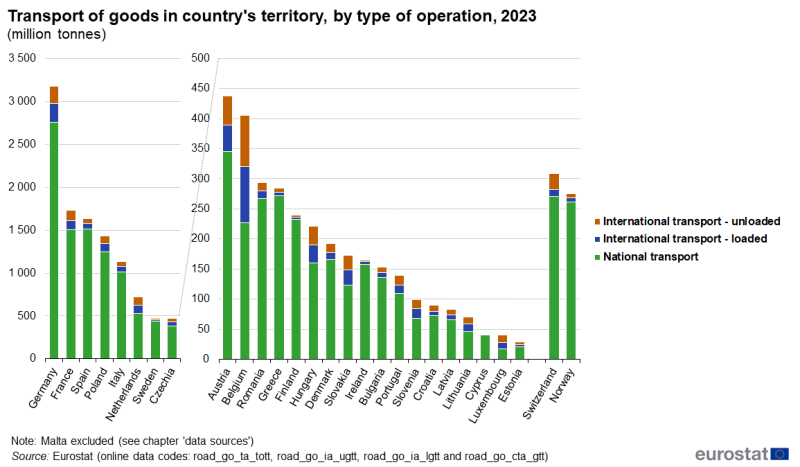
(million tonnes)
Source: Eurostat (road_go_ta_tott), (road_go_ia_ugtt), (road_go_ia_lgtt), (road_go_cta_gtt)
At the level of EU/extra-EU country-to-country freight transport flows (see Table 5), Switzerland, Norway and the United Kingdom were important trading partners. The main extra-EU flows have generally been between these countries and the EU country neighbouring them, except for the United Kingdom. In 2023, the 3 main such traffic flows were between Switzerland and Germany (16.5% of the total extra-EU road transport tonnage), followed by the flow between Norway and Sweden (9.1%) and the flow between Switzerland and France (7.2%).
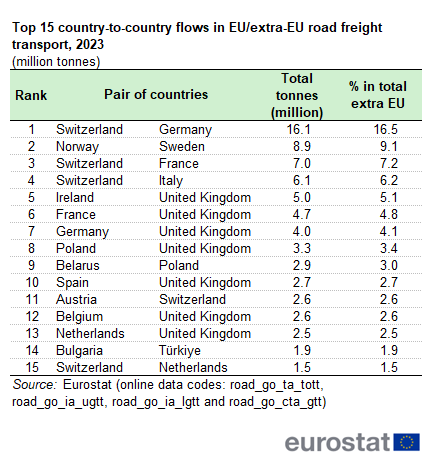
Source: Eurostat (road_go_ta_tott), (road_go_ia_ugtt), (road_go_ia_lgtt), (road_go_cta_gtt)
Table 6 shows the tonnage transported in the top 20 country-to-country flows within the EU, as well as the nationality of the most important hauliers and their shares in the respective transport flows. Germany was either origin or destination in almost half of the top 20 country-to-country flows in 2023, illustrating the central role of Germany in intra-EU trade flows. However, German hauliers’ share of the volumes transported was less than 50% in all country-to-country flows shown in Table 6, with as little as 3.5% in 2023 in the flow between Germany and Poland. German hauliers recorded their highest shares in the transport between Germany and Denmark (45.1%) and between Austria and Germany (28.9%).
The share of hauliers from other EU countries in the country-to-country transport flows varied substantially. In 2023, hauliers from other EU countries than the origin and destination countries carried 62.0% of the total volume transported between Germany and Italy, 58.7% between Germany and France, 58.6% between Belgium and Germany, 55.7% between Austria and Italy, and 52.4% between France and the Netherlands. At the other end of the scale, only 1.2% of the total tonnes between Czechia and Poland, 1.3% between Poland and Slovakia, 1.4% between Germany and Poland and 1.7% between Spain and Portugal were transported by hauliers from other countries.
Among hauliers from other EU countries than the origin and destination, Polish hauliers were by far the most important ones. Of the top 20 intra-EU country-to-country transport flows in 2023, Polish hauliers were the main transporters from and to other EU countries for 13 connections. Of the remaining 7 connections with ‘other hauliers’, Poland was the origin or destination country in 4 connections.
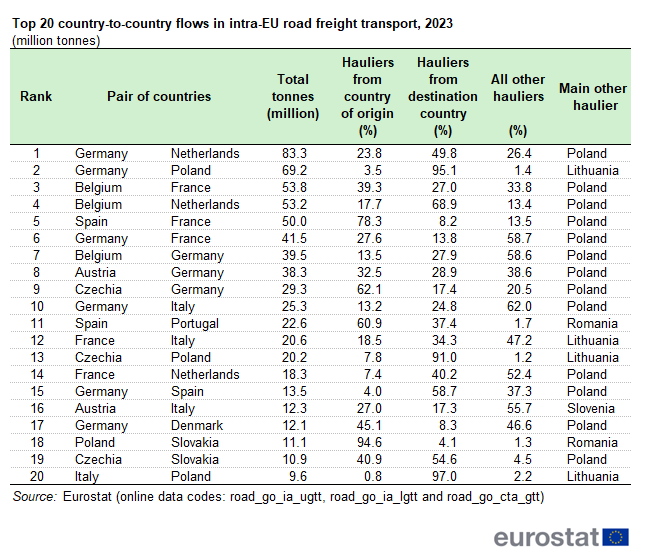
Source: Eurostat (road_go_ia_ugtt), (road_go_ia_lgtt), (road_go_cta_gtt)
Source data for tables and graphs
Context
Data presented in this publication were collected in the framework of Regulation (EU) No 70/2012 on statistical returns in respect of the carriage of goods by road (recast). These data are based on sample surveys carried out in the reporting countries, i.e., the EU Member States, Norway and Switzerland, and record the road goods transport undertaken by vehicles registered in these countries.
Reporting countries use their own national surveys for the collection of data based on returns from road hauliers. The results are microdata referring to vehicles and their linked journeys providing detailed information on goods transported. At the European level, common aggregation procedures have been used that might diverge from national practices. Differences might therefore occur between the figures in this publication and national values. For the distinction between national and international transport, journey information is used at the European level, which might cause differences in corresponding values from those countries that are using goods information for these statistics.
Country specific notes
Croatia: While Croatia had no obligation prior to their accession in 2013, it started to report data for the reference year 2008.
Malta: Regulation (EU) No 70/2012 does not apply to Malta, so long as the number of Maltese-registered goods road transport vehicles licensed to engage in international transport does not exceed 400 vehicles.
Finland: National and international surveys have been harmonised and follow a common methodology from Q1 2011 onwards, leading to a break in time series in 2011.
Sweden: A break in series occurred in 2014 following a change in methodology. On the basis of a specific survey, Sweden corrected the European road freight survey results for trucks participating to the sample which were not in use over the surveyed period.
Liechtenstein: Liechtenstein reports only international road freight transport. Starting with the reference year 2014, Liechtenstein is exempted from the reporting of road freight data.
Methodological notes
EU totals calculated in this publication refer to road freight transport reported by the EU Member States, excluding Malta which is exempted from reporting road freight statistics.
Total transport
Total transport includes national transport, international transport of goods loaded in the reporting countries, international transport of goods unloaded in the reporting countries, cross-trade and cabotage transport.
National transport
Road transport between two places (a place of loading and a place of unloading) located in the same country, by a vehicle registered in that country.
International transport, loaded and unloaded
International transport as presented in this publication is based on goods loaded and unloaded in the reporting Member States. Each reporting country reports all activities of a road motor vehicle inside and outside its national territory. There is thus no risk of double counting at European level.
Breakdown by goods groups
Starting with the reference year 2008, Regulation (EC) No 1304/2007 establishes NST 2007 as the sole classification for goods carried in road freight transport. For detailed information on the NST 2007 classification, please refer to ‘Metadata classification’, Eurostat’s Metadata Server.
Transport by distance class
Eurostat disseminates road freight transport according to the following distance classes: less than 50 km; 50-149 km; 150-299 km; 300-499 km; 500-999 km; 1 000-1 999 km; 2 000-5 999 km; over 6 000 km.
More detailed data and metadata are available in the Eurostat dissemination database.
Goods entering a country
The volume of goods entering a country is the sum of international transport and cross-trade unloaded in the country by hauliers from all reporting countries.
Goods leaving a country
The volume of goods leaving a country is the sum of international transport and cross-trade loaded in the country by hauliers from all reporting countries.
Table 1 vs Table 2
The dissemination tables providing transport performance (in tkm) with a breakdown by group of goods are derived from basic goods transport operations (goods-related information) whereas dissemination tables without a breakdown by group of goods are derived from journey-related information. This may lead to small differences in the total tkm presented in different dissemination tables.
Figure 4
This figure presents volumes moved on the territory of each country if there is loading or unloading of the goods. Transit, where neither loading nor unloading takes place in the country traversed, is not included in this figure. The weight of goods in international transport is accounted for both in the country of loading and in the country of unloading. The weight of goods in national transport is accounted for only once.
Direct access to
- Transport, see:
- Road transport (t_road)
- Transport, see:
- Road transport (road)
- Road freight transport measurement (road_go)
- Key figures on European transport — 2023 edition - Key figures
- Eurostat regional yearbook — 2023 edition - Flagship publications
- Key figures on Europe – 2023 edition - Key figures
- Energy, transport and environment statistics — 2020 edition - Statistical book
- Road freight transport measurement (ESMS metadata file)
- Glossary for transport statistics — 5th edition — 2019 - Manuals and guidelines
- Methodologies used in road freight transport surveys in Member States, EFTA and 3 candidate countries — 2023 edition - Manuals and guidelines
- Road freight transport methodology — Revised edition, August 2017 - Manuals and guidelines
- Regulation (EU) No 70/2012 of 18 January 2012 on statistical returns in respect of the carriage of goods by road (recast)
- Regulation (EC) No 1304/2007 of 7 November 2007 amending Directive 95/64, Regulation (EC) No 1172/98, Regulations (EC) No 91/2003 and (EC) No 1365/2006 with respect to the establishment of NST 2007 as the unique classification for transported goods in certain transport modes